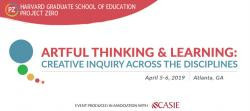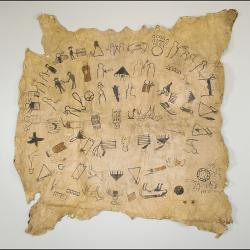Andrea Croft's collections
PZ Perspectives Conference
<p>While they may be little, young children are capable of deep thinking, perspective taking, sharing ideas and taking action; all skills necessary to be an active participant in society. Not only should young children be included and respected as citizens of both the local and global community, fostering these skills encourages the next generation to be invested in the betterment of society. Art is an effective and engaging catalyst to build these civic skills with young children. In this collection, educators from the Smithsonian Early Enrichment Center and the Quaker Valley School District share their use of artwork and thinking routines in their practice with young children. Through hearing stories, seeing examples, and engaging in model lessons, participants will experience relevant thinking routines, have opportunities to reflect on techniques presented and work cooperatively with peers as they create lessons inspired by provided artworks modeled techniques. Participants will leave the session feeling inspired and confident to incorporate art into their practice to build civic skills using demonstrated techniques.</p>
<p><br /></p>
 Andrea Croft
Andrea Croft
49
Behind Design: Exploring American Indian Cultures Through Artifact Investigation
<p><u>Introduction</u></p>
<p>How might we learn about cultures through the study of artifacts? What role could the study of design elements and process play in in deepening our understanding? How could we leverage student agency of the design process to gain opportunities to recognize relationships between artifacts and culture.</p>
<p>This collection provides opportunities for students to uncover complexity by looking closely and making connections between cultures and the design process behind the artifacts. Student claims are based on evidence using provided resources for investigation. The <em>Artifact Investigation Map</em> serves as a visible thinking tool for documenting our understanding of a culture by making connections between the artifact and our research. </p>
<p><u>Procedure</u></p>
<p>Begin by looking closely at an artifact, <em>Lone Dog Winter Count</em>, using a Project Zero Routine, <em>See, Think, Wonder</em>. Through close examination, we begin to develop hypotheses about the object and the connections to the culture. While a main goal is to learn more about the culture related to the artifact, we are also building a capacity for using this thinking process to build understanding. Record and display class ideas generated through this routine. In the discussion of culture, we are looking at how people live: What do the people value? What are their priorities and motivations? </p>
<p>Introduce the points of <em>The Artifact Investigation Map</em>. Ask students, “How could this be used to organize the ideas documented from the thinking routine about the artifact and the people who created it?”. (Students may recognize this as the Engineering Design Process.) Building on our initial <em>See, Think, Wonder</em> documentation, the group connects the artifact ideas to the map points. Different questions within each point may serve as prompts to continue making connections and lead to more questions about what we still wonder, guiding the next research steps. Provide a space to record and share new questions during the process.</p>
<p>Begin the research process with the first video <u></u><em>Lakota Winter Counts</em>. Using information from the source, model the process of organizing the findings using the different points on <em>The Artifact Investigation Map</em>. Be sure to highlight unanswered questions in the map as the class decides the future steps in the research. Support the student use of resource-based evidence starting from this Learning Lab collection when making and documenting claims. Depending on the learners, this phase may vary in the structure of guidance and interaction. Documentation is shared with an emphasis on providing opportunities to discuss the claims, findings, and analysis. </p>
<p><u><br /></u></p>
<p><u>Guiding Points for Inquiry using <em>The Artifact Investigation Map</em>: </u></p>
<p><strong>Ask</strong>: What needs or problems might this artifact address/solve? Does this design reflect empathy for a particular group or person? </p>
<p><strong>Imagine</strong>: What possible prototypes or variations might have been produced in the timeline of this artifact? Could there have been earlier versions leading to this one? </p>
<p><strong>Plan</strong>: Identify and describe what could have been key factors influencing design process. Examples: materials/natural resources, people power, skills, technology/tools, historical and natural environment….</p>
<p><strong>(Re)Create</strong>: Describe the possible steps taken to create the artifact. What could this look like? Options include for this exploration: Try to create a mini-version or reenact one of the steps of the process. Use observations of the process to draw possible conclusions about the culture. Sketch or act out the steps. Take a part of the process and use the <em>Step Inside</em> thinking routine. <strong>*Document and share this process with the group in order to prepare for the next phase of The</strong><em><strong> Artifact Investigation Map</strong></em> </p>
<p><strong>Improvements:</strong> Since the creation of this artifact, what versions do we see today? What would the biography of this type of innovation look like? How might this type of artifact connect to modern innovation? *Extension for Improvements: Use the thinking routine <em>Imagine</em> If to evaluate a modern iteration of the artifact. How does it compare to the original? </p>
<p><u><br /></u></p>
<p><u>Documenting Ongoing Conclusions/Questions/Reflections </u></p>
<p>Throughout the investigation, students share and post supported claims about the culture and reflect upon the process of using the design cycle to guide the study. </p>
<p>For the final reflection, use the thinking routine <em>I Used to Think, Now I Think… </em>to look for changes in thinking. Keep the process and research lines of thinking open for continued exploration with the unanswered questions. </p>
<p>#PZPGH</p>
 Andrea Croft
Andrea Croft
31
Deciphering the Code: Understanding Messages Through Symbol Exploration
<p>This collection provides opportunities for students to uncover the complexity behind symbols found in art and artifacts. Curiosity and wonderment are sparked as students use close looking strategies to precisely describe what they see. Students can then apply these findings to reveal a deeper meaning behind the symbols and the identities of the designer and users. Students will be inspired to create their own stamps as they explore how symbols share messages and bridge connections to people and diverse cultures. </p>
<p></p>
 Andrea Croft
Andrea Croft
31



